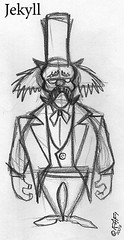
(click on any image for a larger version)
Taking one of the silhouettes from before, I work loose and quick. Building on the shapes I established - trying to give more meaning to what was only implied before. Note how the shapes I employed in the silhouette are used as a guide, while I elaborate on the design by referencing the real world in an effort to support my ideas.
Here's a look at another drawing using the same process:

I avoid getting restricted by the silhouette too much - free to keep exploring variations on the theme. The drawback is that you can often loose the impact of that silhouette. The essence of what it represents is tough to maintain. Again, I'm still drawing quick - staying open to possibilities beyond the first instincts I had.
I wasn't happy with the lack of clarity in these drawings. eg. hands, facial features, the busy-ness in clothing. I felt I could go a lot further with contrast and appeal in my designs. Since I hadn't spent a lot of time on them I wasn't precious about scrapping them. The time wasn't wasted either because I was still moving forward and discovering what did and didn't work.
So I kept going:


I tried to address symmetry and form in the drawings above while still drawing as quick as I could and not get bogged down in details - to keep up with the rate ideas pop up into your head when you're searching. In doing so, that flow continues from drawing to drawing, it's almost sub-concious how a select few concepts from one find themselves moving across and mutating into areas of the next:

I find it's best to keep the process as organic as possible - particularly in the early stages of roughing a character out. The end design may look nothing like these early studies, but that's what's so cool about evolution.

No comments:
Post a Comment